Contemporary Business: Starbucks's External Factors and CSR Analysis
VerifiedAdded on 2024/04/26
|21
|5626
|111
Report
AI Summary
This report provides a comprehensive analysis of Starbucks's external influences and corporate social responsibility (CSR) initiatives. It examines the primary external factors affecting Starbucks, including political, economic, social, technological, environmental, and legal (PESTLE) factors, and assesses their importance to the company's operations. The report also delves into the relevance of CSR to Starbucks, exploring its influence on the company's policies and decision-making processes, and evaluating the effectiveness of Starbucks's CSR responses. Furthermore, it offers suggestions for improvements in Starbucks's CSR practices, emphasizing the importance of ethical sourcing, community engagement, and environmental sustainability. The analysis highlights Starbucks's commitment to supporting farmers and suppliers, providing opportunities for youths, and promoting environmental stewardship. This document is available on Desklib, a platform offering a wide range of study tools and resources for students.
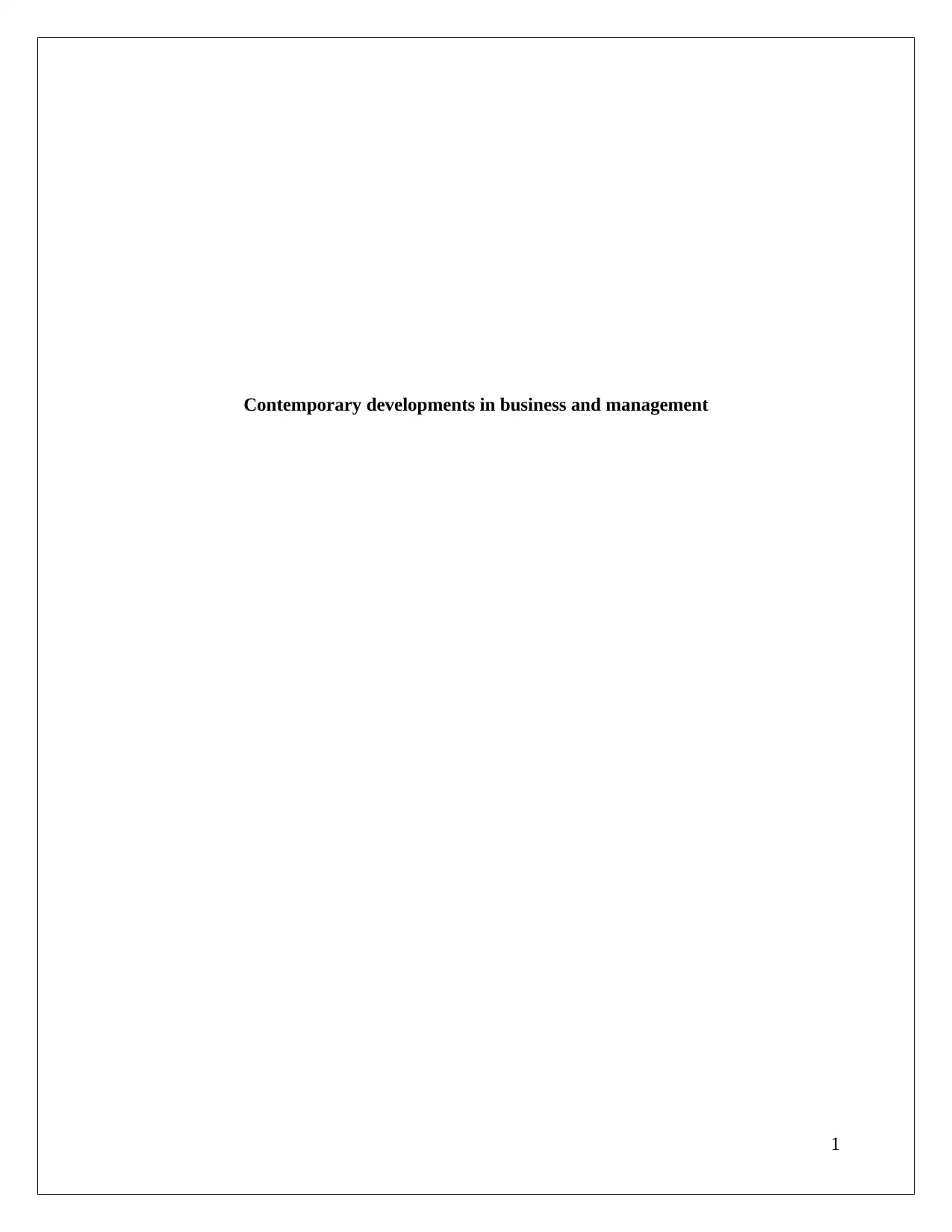
Contemporary developments in business and management
1
1
Paraphrase This Document
Need a fresh take? Get an instant paraphrase of this document with our AI Paraphraser
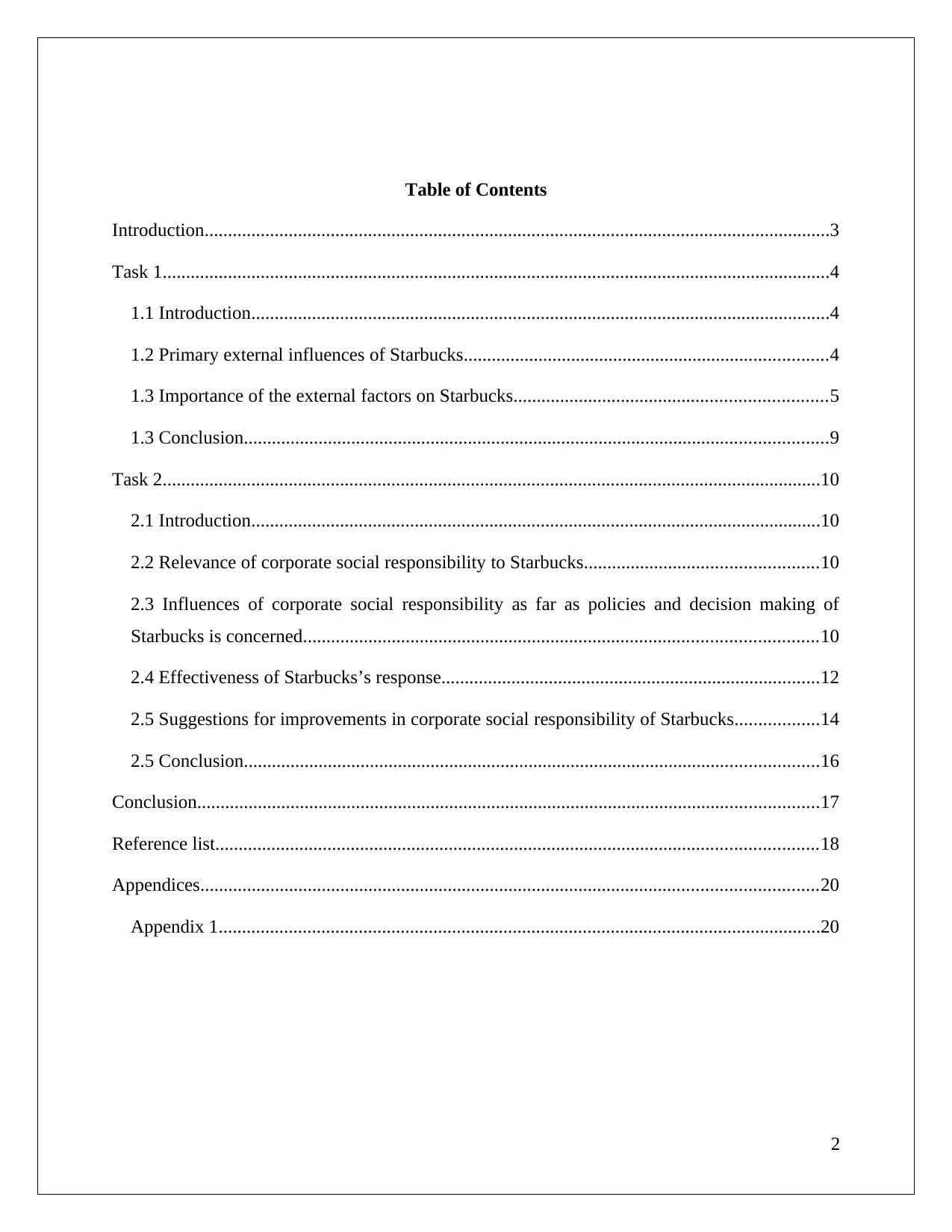
Table of Contents
Introduction......................................................................................................................................3
Task 1...............................................................................................................................................4
1.1 Introduction............................................................................................................................4
1.2 Primary external influences of Starbucks..............................................................................4
1.3 Importance of the external factors on Starbucks...................................................................5
1.3 Conclusion.............................................................................................................................9
Task 2.............................................................................................................................................10
2.1 Introduction..........................................................................................................................10
2.2 Relevance of corporate social responsibility to Starbucks..................................................10
2.3 Influences of corporate social responsibility as far as policies and decision making of
Starbucks is concerned..............................................................................................................10
2.4 Effectiveness of Starbucks’s response.................................................................................12
2.5 Suggestions for improvements in corporate social responsibility of Starbucks..................14
2.5 Conclusion...........................................................................................................................16
Conclusion.....................................................................................................................................17
Reference list.................................................................................................................................18
Appendices....................................................................................................................................20
Appendix 1.................................................................................................................................20
2
Introduction......................................................................................................................................3
Task 1...............................................................................................................................................4
1.1 Introduction............................................................................................................................4
1.2 Primary external influences of Starbucks..............................................................................4
1.3 Importance of the external factors on Starbucks...................................................................5
1.3 Conclusion.............................................................................................................................9
Task 2.............................................................................................................................................10
2.1 Introduction..........................................................................................................................10
2.2 Relevance of corporate social responsibility to Starbucks..................................................10
2.3 Influences of corporate social responsibility as far as policies and decision making of
Starbucks is concerned..............................................................................................................10
2.4 Effectiveness of Starbucks’s response.................................................................................12
2.5 Suggestions for improvements in corporate social responsibility of Starbucks..................14
2.5 Conclusion...........................................................................................................................16
Conclusion.....................................................................................................................................17
Reference list.................................................................................................................................18
Appendices....................................................................................................................................20
Appendix 1.................................................................................................................................20
2
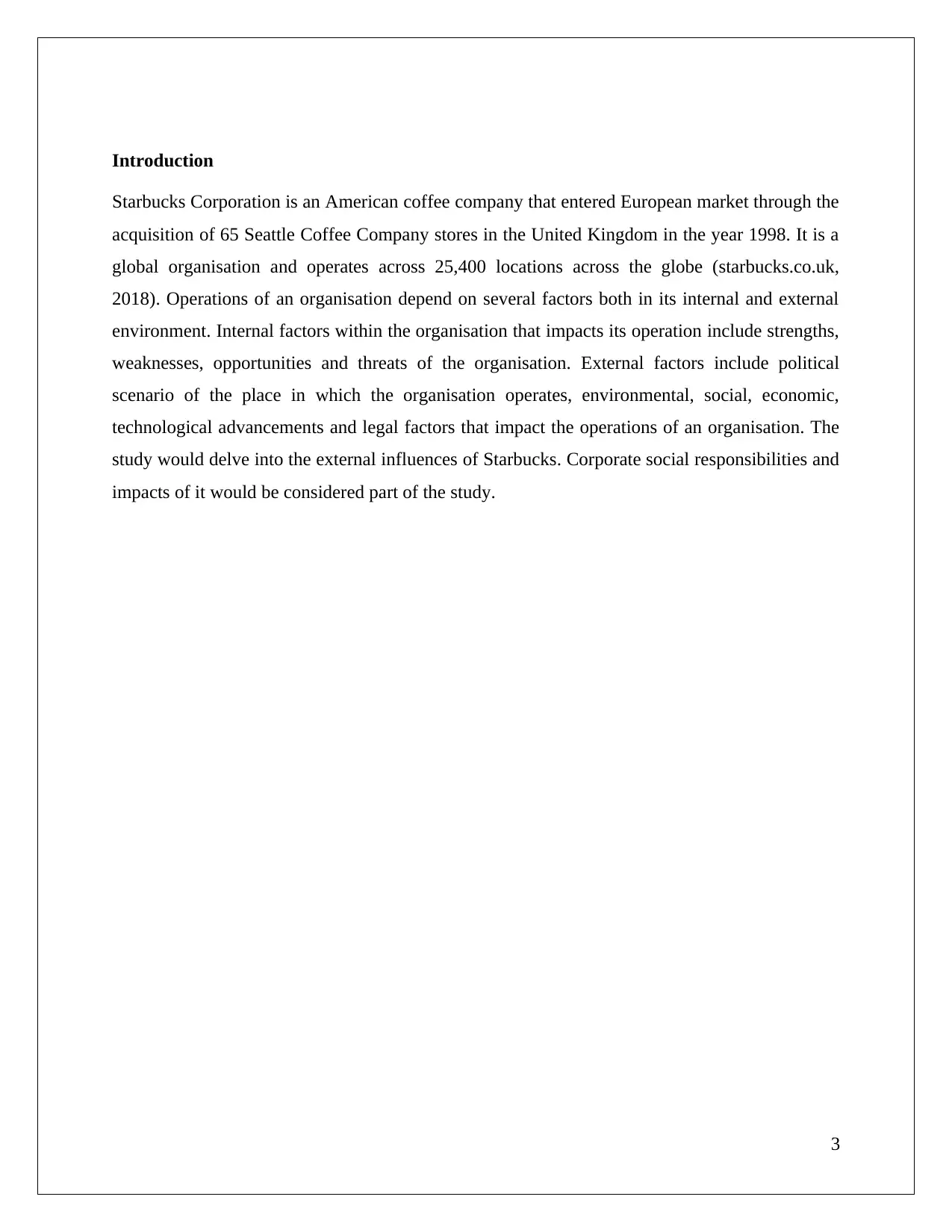
Introduction
Starbucks Corporation is an American coffee company that entered European market through the
acquisition of 65 Seattle Coffee Company stores in the United Kingdom in the year 1998. It is a
global organisation and operates across 25,400 locations across the globe (starbucks.co.uk,
2018). Operations of an organisation depend on several factors both in its internal and external
environment. Internal factors within the organisation that impacts its operation include strengths,
weaknesses, opportunities and threats of the organisation. External factors include political
scenario of the place in which the organisation operates, environmental, social, economic,
technological advancements and legal factors that impact the operations of an organisation. The
study would delve into the external influences of Starbucks. Corporate social responsibilities and
impacts of it would be considered part of the study.
3
Starbucks Corporation is an American coffee company that entered European market through the
acquisition of 65 Seattle Coffee Company stores in the United Kingdom in the year 1998. It is a
global organisation and operates across 25,400 locations across the globe (starbucks.co.uk,
2018). Operations of an organisation depend on several factors both in its internal and external
environment. Internal factors within the organisation that impacts its operation include strengths,
weaknesses, opportunities and threats of the organisation. External factors include political
scenario of the place in which the organisation operates, environmental, social, economic,
technological advancements and legal factors that impact the operations of an organisation. The
study would delve into the external influences of Starbucks. Corporate social responsibilities and
impacts of it would be considered part of the study.
3
⊘ This is a preview!⊘
Do you want full access?
Subscribe today to unlock all pages.

Trusted by 1+ million students worldwide

Task 1
1.1 Introduction
Starbucks operates on a global scale and it has to deal with a wide spectrum of external factors.
The same depends upon the various locations in which the organisation operates. Starbucks is the
leading coffee house company and it continues to lead the industry as far as sustainable business
and innovation is concerned. A significant part of such endeavours are driven by Starbucks’s
ability to address to the external or the PESTLE factors.
1.2 Primary external influences of Starbucks
Attribute Factors
Political Political stability of a country
Regional market integration
Enhancement of governmental support for infrastructure
Economic Growth rate of developing countries
Rise in labour cost
Economic condition of a country
Decline in unemployment rate of a country
Social Affordability of the lower and middle class people
Increase in health consciousness
Growth of coffee culture amongst people
Technological Technology transfer to the coffee farmers
Adaptation of technologies like mobile phones and tablets
by people
Availability of coffee machines and other advanced
technologies for home use
Legal Product safety regulations
4
1.1 Introduction
Starbucks operates on a global scale and it has to deal with a wide spectrum of external factors.
The same depends upon the various locations in which the organisation operates. Starbucks is the
leading coffee house company and it continues to lead the industry as far as sustainable business
and innovation is concerned. A significant part of such endeavours are driven by Starbucks’s
ability to address to the external or the PESTLE factors.
1.2 Primary external influences of Starbucks
Attribute Factors
Political Political stability of a country
Regional market integration
Enhancement of governmental support for infrastructure
Economic Growth rate of developing countries
Rise in labour cost
Economic condition of a country
Decline in unemployment rate of a country
Social Affordability of the lower and middle class people
Increase in health consciousness
Growth of coffee culture amongst people
Technological Technology transfer to the coffee farmers
Adaptation of technologies like mobile phones and tablets
by people
Availability of coffee machines and other advanced
technologies for home use
Legal Product safety regulations
4
Paraphrase This Document
Need a fresh take? Get an instant paraphrase of this document with our AI Paraphraser
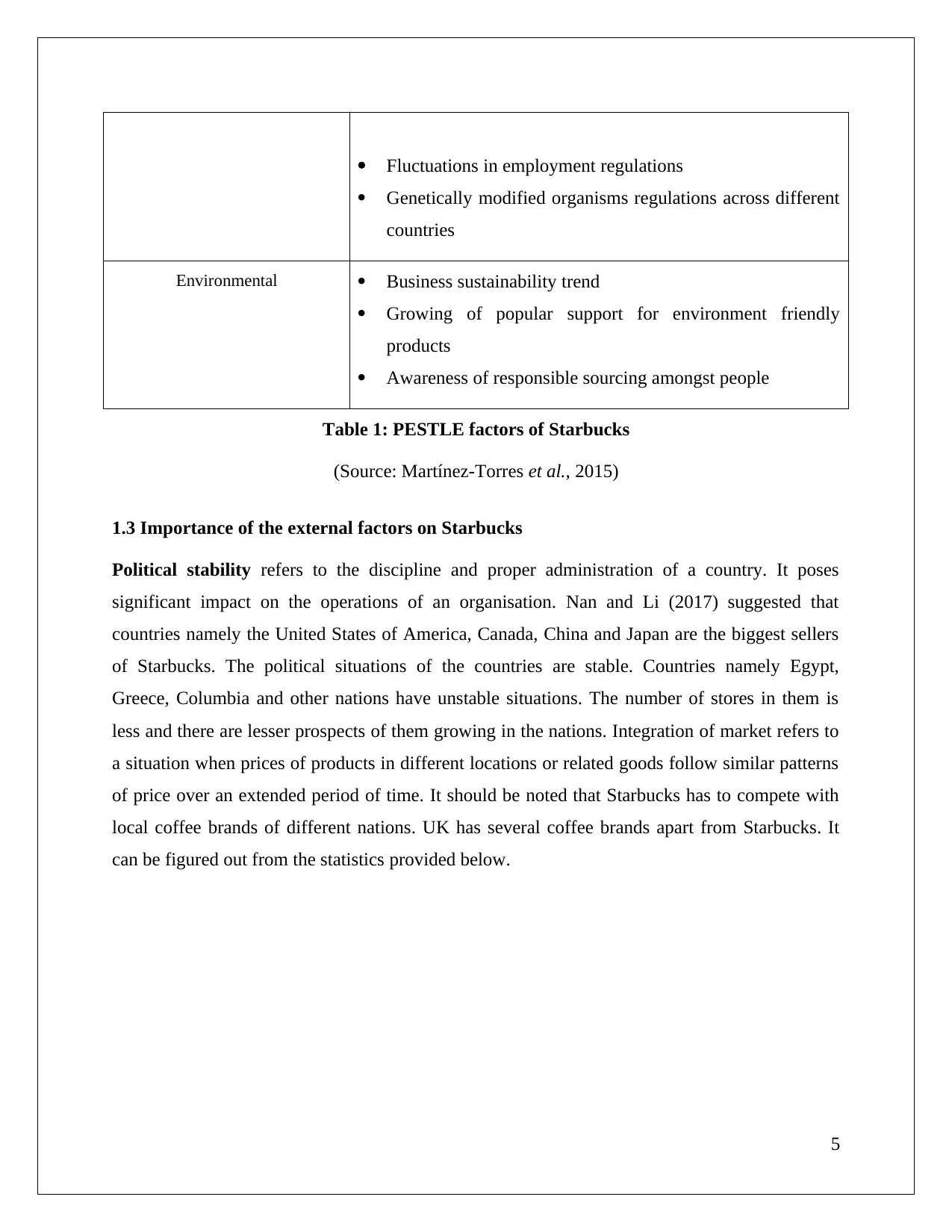
Fluctuations in employment regulations
Genetically modified organisms regulations across different
countries
Environmental Business sustainability trend
Growing of popular support for environment friendly
products
Awareness of responsible sourcing amongst people
Table 1: PESTLE factors of Starbucks
(Source: Martínez-Torres et al., 2015)
1.3 Importance of the external factors on Starbucks
Political stability refers to the discipline and proper administration of a country. It poses
significant impact on the operations of an organisation. Nan and Li (2017) suggested that
countries namely the United States of America, Canada, China and Japan are the biggest sellers
of Starbucks. The political situations of the countries are stable. Countries namely Egypt,
Greece, Columbia and other nations have unstable situations. The number of stores in them is
less and there are lesser prospects of them growing in the nations. Integration of market refers to
a situation when prices of products in different locations or related goods follow similar patterns
of price over an extended period of time. It should be noted that Starbucks has to compete with
local coffee brands of different nations. UK has several coffee brands apart from Starbucks. It
can be figured out from the statistics provided below.
5
Genetically modified organisms regulations across different
countries
Environmental Business sustainability trend
Growing of popular support for environment friendly
products
Awareness of responsible sourcing amongst people
Table 1: PESTLE factors of Starbucks
(Source: Martínez-Torres et al., 2015)
1.3 Importance of the external factors on Starbucks
Political stability refers to the discipline and proper administration of a country. It poses
significant impact on the operations of an organisation. Nan and Li (2017) suggested that
countries namely the United States of America, Canada, China and Japan are the biggest sellers
of Starbucks. The political situations of the countries are stable. Countries namely Egypt,
Greece, Columbia and other nations have unstable situations. The number of stores in them is
less and there are lesser prospects of them growing in the nations. Integration of market refers to
a situation when prices of products in different locations or related goods follow similar patterns
of price over an extended period of time. It should be noted that Starbucks has to compete with
local coffee brands of different nations. UK has several coffee brands apart from Starbucks. It
can be figured out from the statistics provided below.
5
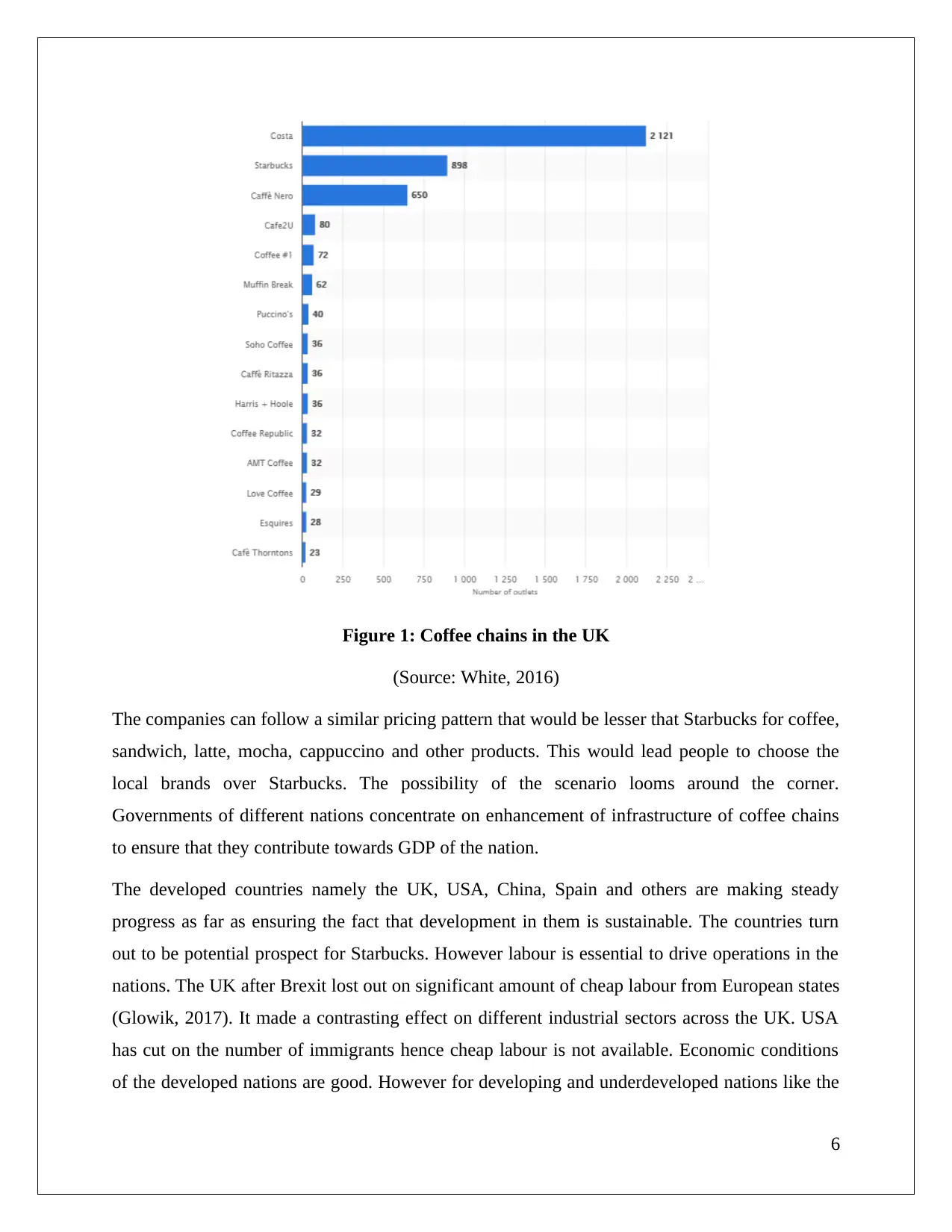
Figure 1: Coffee chains in the UK
(Source: White, 2016)
The companies can follow a similar pricing pattern that would be lesser that Starbucks for coffee,
sandwich, latte, mocha, cappuccino and other products. This would lead people to choose the
local brands over Starbucks. The possibility of the scenario looms around the corner.
Governments of different nations concentrate on enhancement of infrastructure of coffee chains
to ensure that they contribute towards GDP of the nation.
The developed countries namely the UK, USA, China, Spain and others are making steady
progress as far as ensuring the fact that development in them is sustainable. The countries turn
out to be potential prospect for Starbucks. However labour is essential to drive operations in the
nations. The UK after Brexit lost out on significant amount of cheap labour from European states
(Glowik, 2017). It made a contrasting effect on different industrial sectors across the UK. USA
has cut on the number of immigrants hence cheap labour is not available. Economic conditions
of the developed nations are good. However for developing and underdeveloped nations like the
6
(Source: White, 2016)
The companies can follow a similar pricing pattern that would be lesser that Starbucks for coffee,
sandwich, latte, mocha, cappuccino and other products. This would lead people to choose the
local brands over Starbucks. The possibility of the scenario looms around the corner.
Governments of different nations concentrate on enhancement of infrastructure of coffee chains
to ensure that they contribute towards GDP of the nation.
The developed countries namely the UK, USA, China, Spain and others are making steady
progress as far as ensuring the fact that development in them is sustainable. The countries turn
out to be potential prospect for Starbucks. However labour is essential to drive operations in the
nations. The UK after Brexit lost out on significant amount of cheap labour from European states
(Glowik, 2017). It made a contrasting effect on different industrial sectors across the UK. USA
has cut on the number of immigrants hence cheap labour is not available. Economic conditions
of the developed nations are good. However for developing and underdeveloped nations like the
6
⊘ This is a preview!⊘
Do you want full access?
Subscribe today to unlock all pages.

Trusted by 1+ million students worldwide
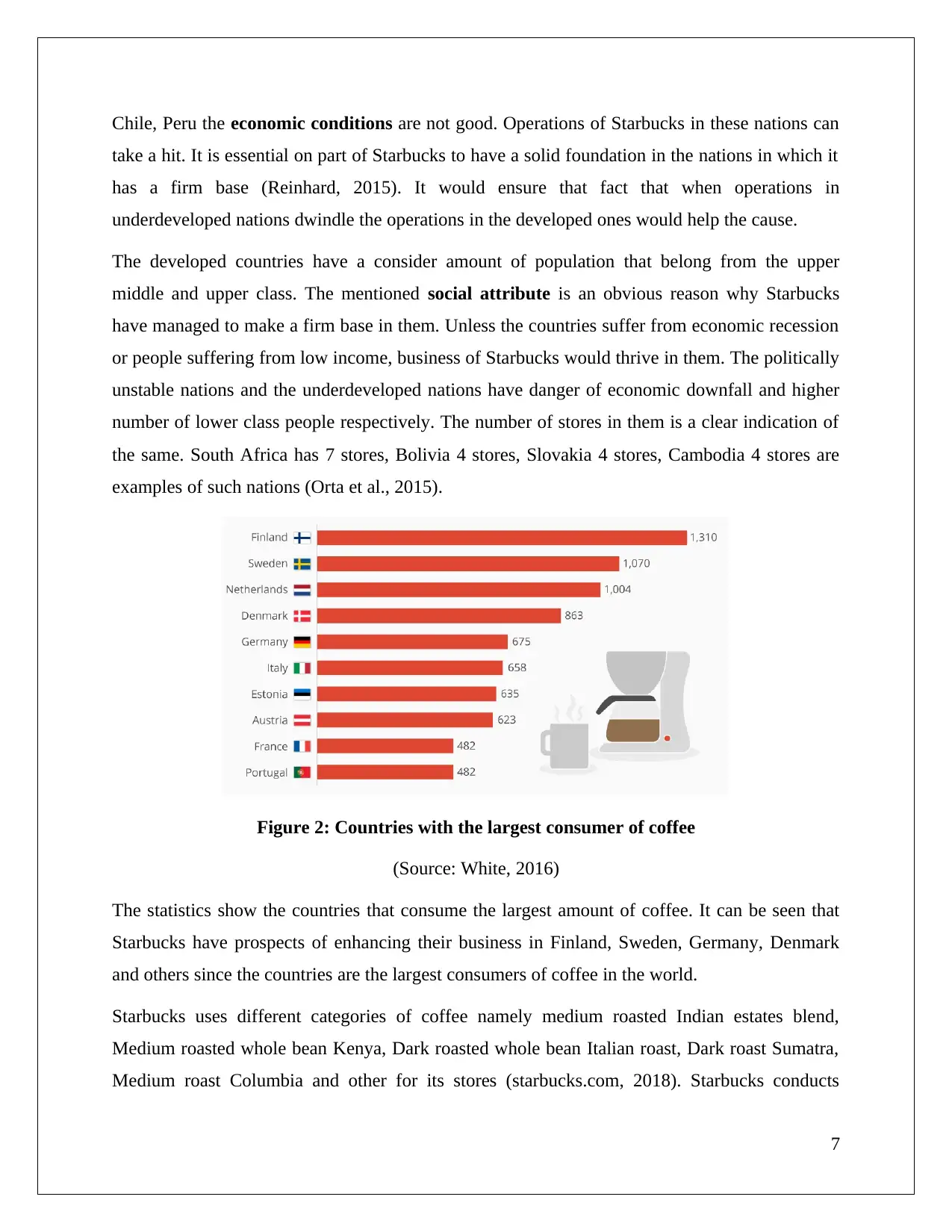
Chile, Peru the economic conditions are not good. Operations of Starbucks in these nations can
take a hit. It is essential on part of Starbucks to have a solid foundation in the nations in which it
has a firm base (Reinhard, 2015). It would ensure that fact that when operations in
underdeveloped nations dwindle the operations in the developed ones would help the cause.
The developed countries have a consider amount of population that belong from the upper
middle and upper class. The mentioned social attribute is an obvious reason why Starbucks
have managed to make a firm base in them. Unless the countries suffer from economic recession
or people suffering from low income, business of Starbucks would thrive in them. The politically
unstable nations and the underdeveloped nations have danger of economic downfall and higher
number of lower class people respectively. The number of stores in them is a clear indication of
the same. South Africa has 7 stores, Bolivia 4 stores, Slovakia 4 stores, Cambodia 4 stores are
examples of such nations (Orta et al., 2015).
Figure 2: Countries with the largest consumer of coffee
(Source: White, 2016)
The statistics show the countries that consume the largest amount of coffee. It can be seen that
Starbucks have prospects of enhancing their business in Finland, Sweden, Germany, Denmark
and others since the countries are the largest consumers of coffee in the world.
Starbucks uses different categories of coffee namely medium roasted Indian estates blend,
Medium roasted whole bean Kenya, Dark roasted whole bean Italian roast, Dark roast Sumatra,
Medium roast Columbia and other for its stores (starbucks.com, 2018). Starbucks conducts
7
take a hit. It is essential on part of Starbucks to have a solid foundation in the nations in which it
has a firm base (Reinhard, 2015). It would ensure that fact that when operations in
underdeveloped nations dwindle the operations in the developed ones would help the cause.
The developed countries have a consider amount of population that belong from the upper
middle and upper class. The mentioned social attribute is an obvious reason why Starbucks
have managed to make a firm base in them. Unless the countries suffer from economic recession
or people suffering from low income, business of Starbucks would thrive in them. The politically
unstable nations and the underdeveloped nations have danger of economic downfall and higher
number of lower class people respectively. The number of stores in them is a clear indication of
the same. South Africa has 7 stores, Bolivia 4 stores, Slovakia 4 stores, Cambodia 4 stores are
examples of such nations (Orta et al., 2015).
Figure 2: Countries with the largest consumer of coffee
(Source: White, 2016)
The statistics show the countries that consume the largest amount of coffee. It can be seen that
Starbucks have prospects of enhancing their business in Finland, Sweden, Germany, Denmark
and others since the countries are the largest consumers of coffee in the world.
Starbucks uses different categories of coffee namely medium roasted Indian estates blend,
Medium roasted whole bean Kenya, Dark roasted whole bean Italian roast, Dark roast Sumatra,
Medium roast Columbia and other for its stores (starbucks.com, 2018). Starbucks conducts
7
Paraphrase This Document
Need a fresh take? Get an instant paraphrase of this document with our AI Paraphraser

intensive market research to obtain the categories of coffee so that it earns a competitive edge in
the technological department. Marketing is another aspect of Starbucks that has helped it attain
a competitive edge. It uses social media to market its products. In 2010 it earned the most
popular social media brand by the followers of Fame count, an online statistics and analytics
provider. Starbucks has its own mobile applications besides its website to facilitate consumers as
far as viewing their products is concerned (Glowik, 2017). The application facilitates purchasing
of Starbucks products. It is available on Blackberry, Android and iPhone. Coffee machines are
an integral part of a coffee store and Starbucks is no exception of it.
Haskova (2015) put forward that Starbucks believes in the importance of caring for earth. It
encourages others to achieve the same. It uses environment friendly cups for its stores. It
constantly works on its recycling program to reduce the amount of waste generated. It uses
renewable sources of energy to reduce environmental impact. It constantly works towards
minimizing utility of energy consumption. It uses less water for its operations. It concentrates on
making its stores green by virtue of using responsible building materials and energy efficient
techniques to contribute towards environmental footprint. The government of diffident nations
have become aware of environmental damages and have started to take active measures as far as
mitigating them is concerned. Starbucks by virtue of its activities that contribute towards
environmental sustainability is assured of grabbing the attention of governments across several
nations of the world.
As far as the legal aspect is concerned, Starbucks’s success has always been dependent on the
farmers and suppliers who contribute towards growth and production of the products like tea,
coffee, cocoa and other manufactured services and goods. It is committed towards providing
ethically and responsibly purchased products that are of the highest quality. Since 2006, it started
the Starbucks annual Supplier Summit in China. It congregates stakeholders and focuses on
improving working conditions in areas where its products are sourced. It offers technical training
to support suppliers and factories in the efforts to ethically source superior quality products (Nan
and Li, 2017).
8
the technological department. Marketing is another aspect of Starbucks that has helped it attain
a competitive edge. It uses social media to market its products. In 2010 it earned the most
popular social media brand by the followers of Fame count, an online statistics and analytics
provider. Starbucks has its own mobile applications besides its website to facilitate consumers as
far as viewing their products is concerned (Glowik, 2017). The application facilitates purchasing
of Starbucks products. It is available on Blackberry, Android and iPhone. Coffee machines are
an integral part of a coffee store and Starbucks is no exception of it.
Haskova (2015) put forward that Starbucks believes in the importance of caring for earth. It
encourages others to achieve the same. It uses environment friendly cups for its stores. It
constantly works on its recycling program to reduce the amount of waste generated. It uses
renewable sources of energy to reduce environmental impact. It constantly works towards
minimizing utility of energy consumption. It uses less water for its operations. It concentrates on
making its stores green by virtue of using responsible building materials and energy efficient
techniques to contribute towards environmental footprint. The government of diffident nations
have become aware of environmental damages and have started to take active measures as far as
mitigating them is concerned. Starbucks by virtue of its activities that contribute towards
environmental sustainability is assured of grabbing the attention of governments across several
nations of the world.
As far as the legal aspect is concerned, Starbucks’s success has always been dependent on the
farmers and suppliers who contribute towards growth and production of the products like tea,
coffee, cocoa and other manufactured services and goods. It is committed towards providing
ethically and responsibly purchased products that are of the highest quality. Since 2006, it started
the Starbucks annual Supplier Summit in China. It congregates stakeholders and focuses on
improving working conditions in areas where its products are sourced. It offers technical training
to support suppliers and factories in the efforts to ethically source superior quality products (Nan
and Li, 2017).
8
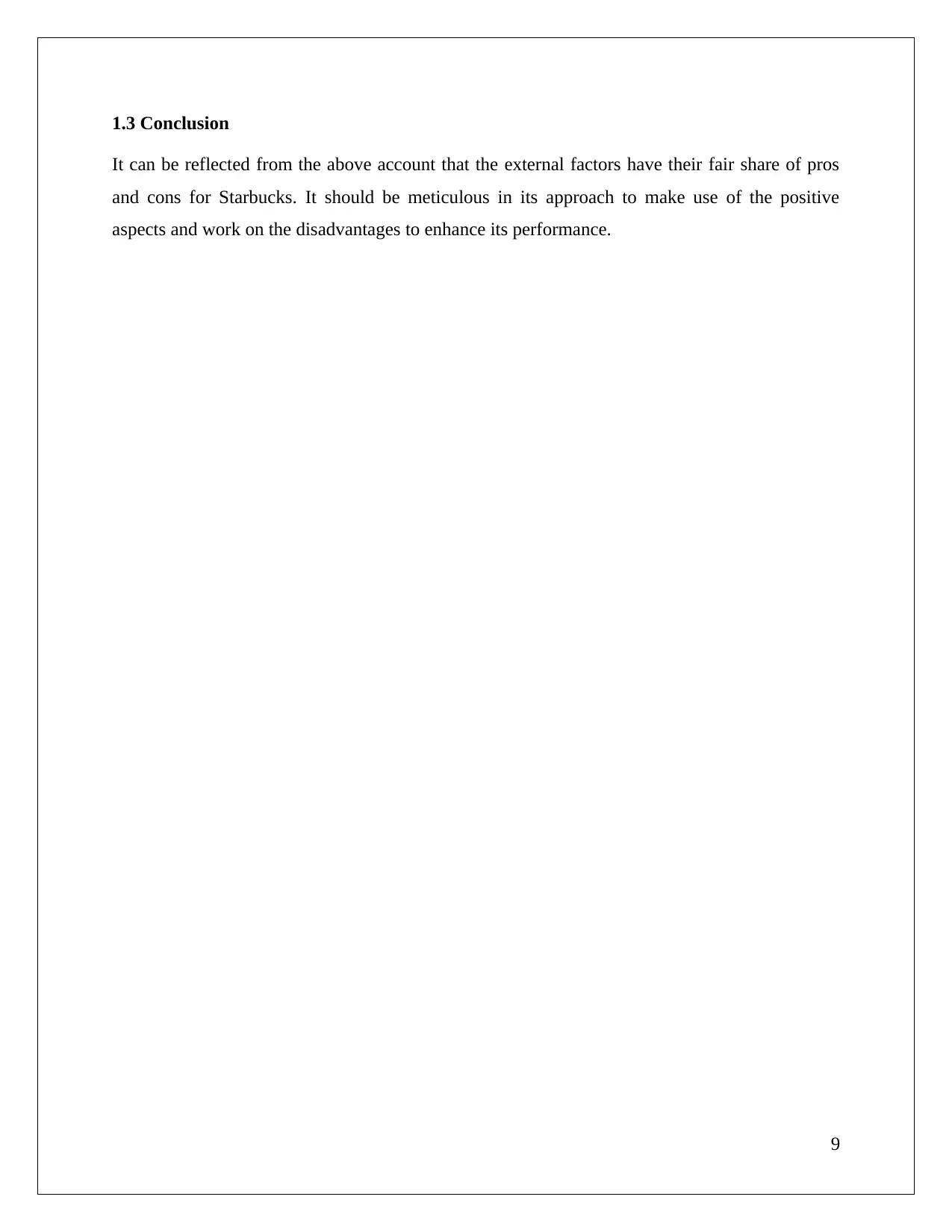
1.3 Conclusion
It can be reflected from the above account that the external factors have their fair share of pros
and cons for Starbucks. It should be meticulous in its approach to make use of the positive
aspects and work on the disadvantages to enhance its performance.
9
It can be reflected from the above account that the external factors have their fair share of pros
and cons for Starbucks. It should be meticulous in its approach to make use of the positive
aspects and work on the disadvantages to enhance its performance.
9
⊘ This is a preview!⊘
Do you want full access?
Subscribe today to unlock all pages.

Trusted by 1+ million students worldwide
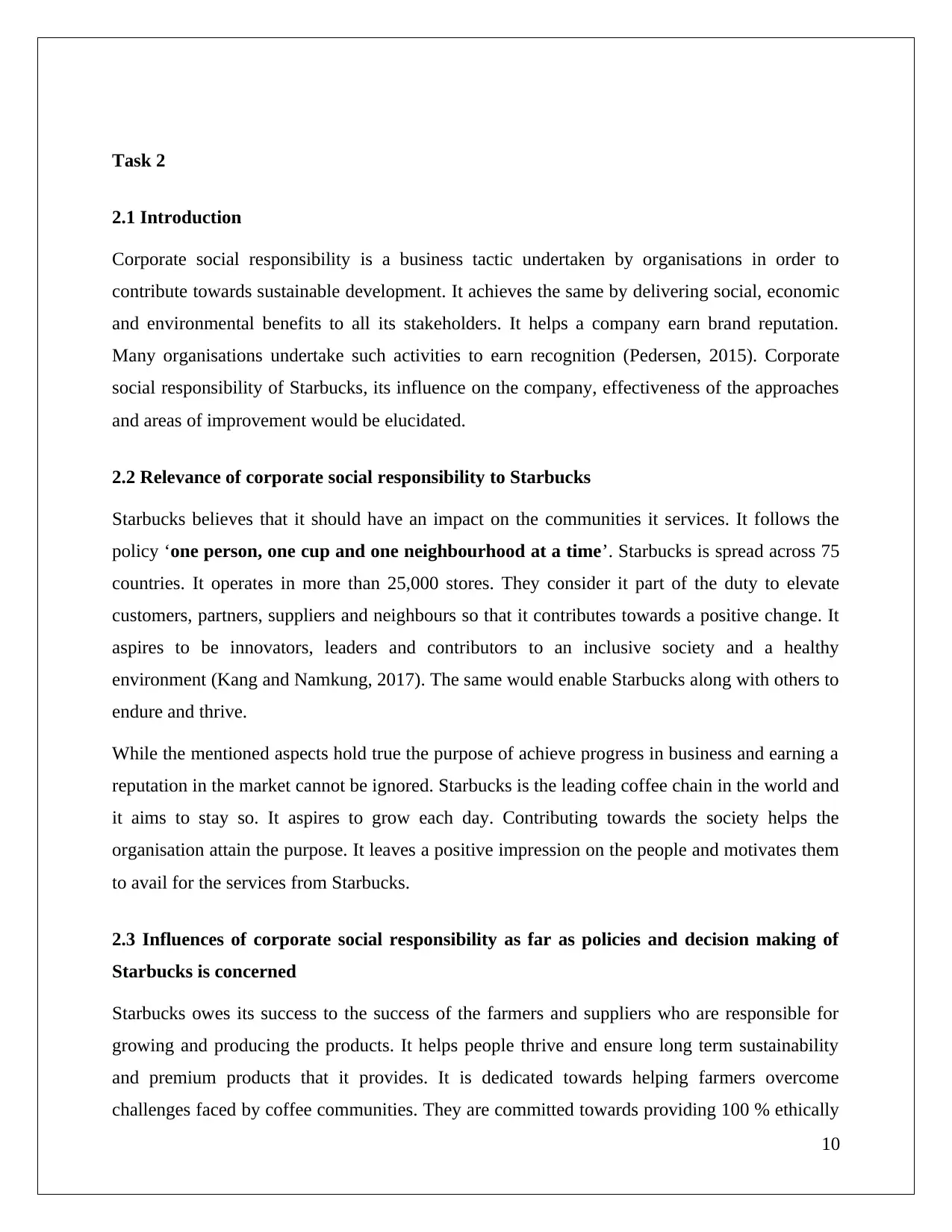
Task 2
2.1 Introduction
Corporate social responsibility is a business tactic undertaken by organisations in order to
contribute towards sustainable development. It achieves the same by delivering social, economic
and environmental benefits to all its stakeholders. It helps a company earn brand reputation.
Many organisations undertake such activities to earn recognition (Pedersen, 2015). Corporate
social responsibility of Starbucks, its influence on the company, effectiveness of the approaches
and areas of improvement would be elucidated.
2.2 Relevance of corporate social responsibility to Starbucks
Starbucks believes that it should have an impact on the communities it services. It follows the
policy ‘one person, one cup and one neighbourhood at a time’. Starbucks is spread across 75
countries. It operates in more than 25,000 stores. They consider it part of the duty to elevate
customers, partners, suppliers and neighbours so that it contributes towards a positive change. It
aspires to be innovators, leaders and contributors to an inclusive society and a healthy
environment (Kang and Namkung, 2017). The same would enable Starbucks along with others to
endure and thrive.
While the mentioned aspects hold true the purpose of achieve progress in business and earning a
reputation in the market cannot be ignored. Starbucks is the leading coffee chain in the world and
it aims to stay so. It aspires to grow each day. Contributing towards the society helps the
organisation attain the purpose. It leaves a positive impression on the people and motivates them
to avail for the services from Starbucks.
2.3 Influences of corporate social responsibility as far as policies and decision making of
Starbucks is concerned
Starbucks owes its success to the success of the farmers and suppliers who are responsible for
growing and producing the products. It helps people thrive and ensure long term sustainability
and premium products that it provides. It is dedicated towards helping farmers overcome
challenges faced by coffee communities. They are committed towards providing 100 % ethically
10
2.1 Introduction
Corporate social responsibility is a business tactic undertaken by organisations in order to
contribute towards sustainable development. It achieves the same by delivering social, economic
and environmental benefits to all its stakeholders. It helps a company earn brand reputation.
Many organisations undertake such activities to earn recognition (Pedersen, 2015). Corporate
social responsibility of Starbucks, its influence on the company, effectiveness of the approaches
and areas of improvement would be elucidated.
2.2 Relevance of corporate social responsibility to Starbucks
Starbucks believes that it should have an impact on the communities it services. It follows the
policy ‘one person, one cup and one neighbourhood at a time’. Starbucks is spread across 75
countries. It operates in more than 25,000 stores. They consider it part of the duty to elevate
customers, partners, suppliers and neighbours so that it contributes towards a positive change. It
aspires to be innovators, leaders and contributors to an inclusive society and a healthy
environment (Kang and Namkung, 2017). The same would enable Starbucks along with others to
endure and thrive.
While the mentioned aspects hold true the purpose of achieve progress in business and earning a
reputation in the market cannot be ignored. Starbucks is the leading coffee chain in the world and
it aims to stay so. It aspires to grow each day. Contributing towards the society helps the
organisation attain the purpose. It leaves a positive impression on the people and motivates them
to avail for the services from Starbucks.
2.3 Influences of corporate social responsibility as far as policies and decision making of
Starbucks is concerned
Starbucks owes its success to the success of the farmers and suppliers who are responsible for
growing and producing the products. It helps people thrive and ensure long term sustainability
and premium products that it provides. It is dedicated towards helping farmers overcome
challenges faced by coffee communities. They are committed towards providing 100 % ethically
10
Paraphrase This Document
Need a fresh take? Get an instant paraphrase of this document with our AI Paraphraser
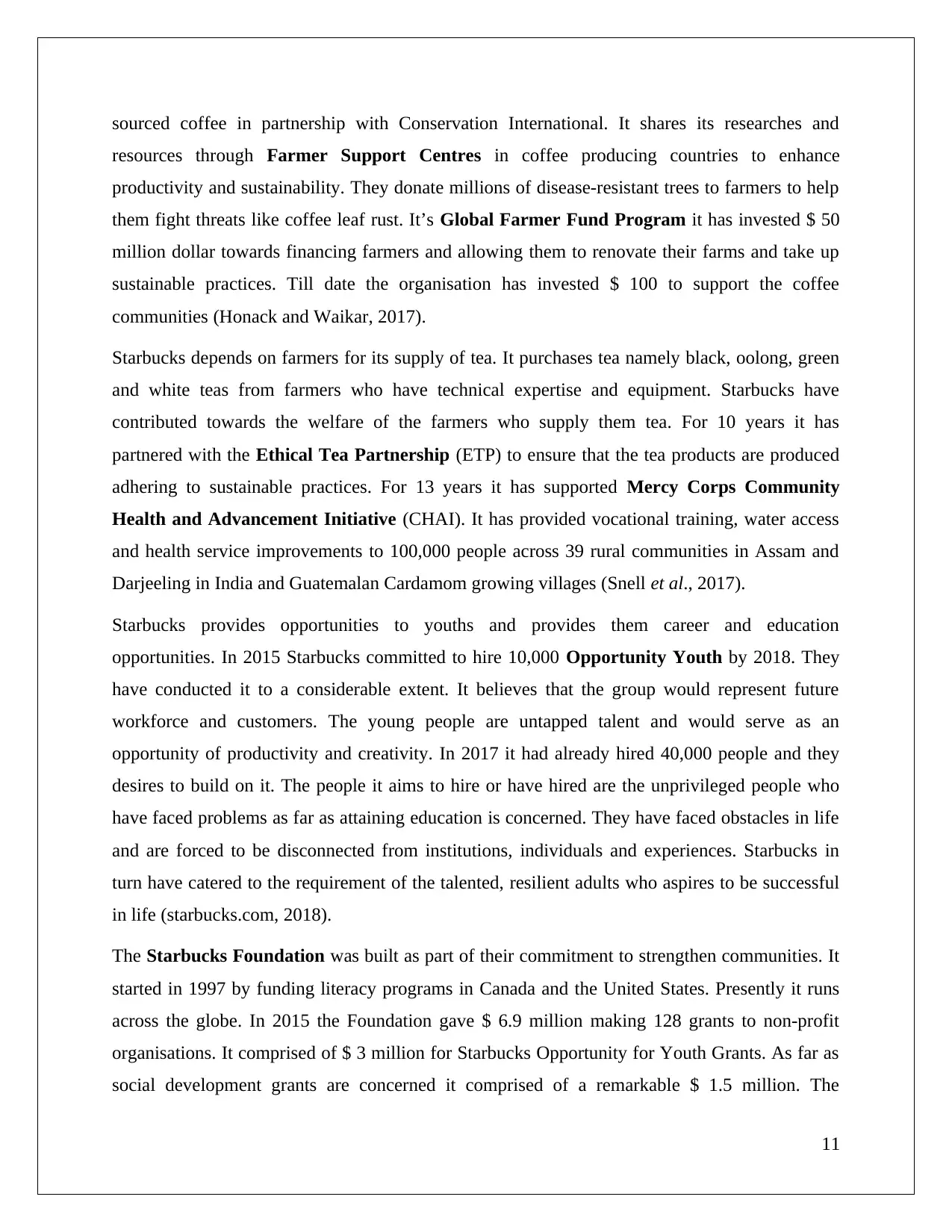
sourced coffee in partnership with Conservation International. It shares its researches and
resources through Farmer Support Centres in coffee producing countries to enhance
productivity and sustainability. They donate millions of disease-resistant trees to farmers to help
them fight threats like coffee leaf rust. It’s Global Farmer Fund Program it has invested $ 50
million dollar towards financing farmers and allowing them to renovate their farms and take up
sustainable practices. Till date the organisation has invested $ 100 to support the coffee
communities (Honack and Waikar, 2017).
Starbucks depends on farmers for its supply of tea. It purchases tea namely black, oolong, green
and white teas from farmers who have technical expertise and equipment. Starbucks have
contributed towards the welfare of the farmers who supply them tea. For 10 years it has
partnered with the Ethical Tea Partnership (ETP) to ensure that the tea products are produced
adhering to sustainable practices. For 13 years it has supported Mercy Corps Community
Health and Advancement Initiative (CHAI). It has provided vocational training, water access
and health service improvements to 100,000 people across 39 rural communities in Assam and
Darjeeling in India and Guatemalan Cardamom growing villages (Snell et al., 2017).
Starbucks provides opportunities to youths and provides them career and education
opportunities. In 2015 Starbucks committed to hire 10,000 Opportunity Youth by 2018. They
have conducted it to a considerable extent. It believes that the group would represent future
workforce and customers. The young people are untapped talent and would serve as an
opportunity of productivity and creativity. In 2017 it had already hired 40,000 people and they
desires to build on it. The people it aims to hire or have hired are the unprivileged people who
have faced problems as far as attaining education is concerned. They have faced obstacles in life
and are forced to be disconnected from institutions, individuals and experiences. Starbucks in
turn have catered to the requirement of the talented, resilient adults who aspires to be successful
in life (starbucks.com, 2018).
The Starbucks Foundation was built as part of their commitment to strengthen communities. It
started in 1997 by funding literacy programs in Canada and the United States. Presently it runs
across the globe. In 2015 the Foundation gave $ 6.9 million making 128 grants to non-profit
organisations. It comprised of $ 3 million for Starbucks Opportunity for Youth Grants. As far as
social development grants are concerned it comprised of a remarkable $ 1.5 million. The
11
resources through Farmer Support Centres in coffee producing countries to enhance
productivity and sustainability. They donate millions of disease-resistant trees to farmers to help
them fight threats like coffee leaf rust. It’s Global Farmer Fund Program it has invested $ 50
million dollar towards financing farmers and allowing them to renovate their farms and take up
sustainable practices. Till date the organisation has invested $ 100 to support the coffee
communities (Honack and Waikar, 2017).
Starbucks depends on farmers for its supply of tea. It purchases tea namely black, oolong, green
and white teas from farmers who have technical expertise and equipment. Starbucks have
contributed towards the welfare of the farmers who supply them tea. For 10 years it has
partnered with the Ethical Tea Partnership (ETP) to ensure that the tea products are produced
adhering to sustainable practices. For 13 years it has supported Mercy Corps Community
Health and Advancement Initiative (CHAI). It has provided vocational training, water access
and health service improvements to 100,000 people across 39 rural communities in Assam and
Darjeeling in India and Guatemalan Cardamom growing villages (Snell et al., 2017).
Starbucks provides opportunities to youths and provides them career and education
opportunities. In 2015 Starbucks committed to hire 10,000 Opportunity Youth by 2018. They
have conducted it to a considerable extent. It believes that the group would represent future
workforce and customers. The young people are untapped talent and would serve as an
opportunity of productivity and creativity. In 2017 it had already hired 40,000 people and they
desires to build on it. The people it aims to hire or have hired are the unprivileged people who
have faced problems as far as attaining education is concerned. They have faced obstacles in life
and are forced to be disconnected from institutions, individuals and experiences. Starbucks in
turn have catered to the requirement of the talented, resilient adults who aspires to be successful
in life (starbucks.com, 2018).
The Starbucks Foundation was built as part of their commitment to strengthen communities. It
started in 1997 by funding literacy programs in Canada and the United States. Presently it runs
across the globe. In 2015 the Foundation gave $ 6.9 million making 128 grants to non-profit
organisations. It comprised of $ 3 million for Starbucks Opportunity for Youth Grants. As far as
social development grants are concerned it comprised of a remarkable $ 1.5 million. The
11

foundations support partner’s engagement in the local community through Community Service
Grants and Partner Match. It provides matching grants to non-profits where partners contribute
towards time and monetary fields (starbucks.com, 2018).
Starbucks Global Farmer Fund comprise of a $ 50 million commitment towards providing
financial aid to coffee farmers. The amount would help the organisation to repay loans and be
able to support restoration, agronomy and infrastructure improvements. The particular endeavour
of Starbuck began in 2000. It has helped cooperatives to deal with risks and enhance their
business. As of 2017 its loan commitment was $ 23 million (Boone, 2017).
Catering towards environment should be integral towards operation of any organisation.
Starbucks commits to the same by different ways. Starbucks follows recycling of cups and otter
packaging materials. In 2006, in North America, it started to offer cups with 10 % post-consumer
recycled paper fibre (starbucks.com, 2018). Reusable cups are an essential aspect towards its
overall waste reduction. Since 1985 it has started rewarding customers who bring their own
tumblers. In 2013 it launched $ 2 reusable cups in Canada and the USA and 1 Pound cup in the
UK (Boone, 2017). However, such initiatives taken by a single company has failed to attain
results on a wide scale. It contributed towards environmental sustainability in a limited way.
Same initiative undertaken by other organisations would promote environmental sustainability
on a significant scale.
2.4 Effectiveness of Starbucks’s response
Corporate social responsibility serves two core purposes at a single time. It contributes towards
welfare of the society, community and in turn help the company earn a brand reputation. By
virtue of ensuring care towards farmers and suppliers they have helped them to a significant
amount. The farmers are not often financially secure and do not receive rewards for the hard
work they put in. Starbucks had the acumen to think of the aspect and have funds ready for them.
It has helped people farmers repay loans and enable them to afford raw materials and other
essentialities. It has made sure that farmers remain in good terms with Starbucks and produces
the best materials for them (starbucks.co.uk, 2018).
Response of Starbucks and its effectiveness
12
Grants and Partner Match. It provides matching grants to non-profits where partners contribute
towards time and monetary fields (starbucks.com, 2018).
Starbucks Global Farmer Fund comprise of a $ 50 million commitment towards providing
financial aid to coffee farmers. The amount would help the organisation to repay loans and be
able to support restoration, agronomy and infrastructure improvements. The particular endeavour
of Starbuck began in 2000. It has helped cooperatives to deal with risks and enhance their
business. As of 2017 its loan commitment was $ 23 million (Boone, 2017).
Catering towards environment should be integral towards operation of any organisation.
Starbucks commits to the same by different ways. Starbucks follows recycling of cups and otter
packaging materials. In 2006, in North America, it started to offer cups with 10 % post-consumer
recycled paper fibre (starbucks.com, 2018). Reusable cups are an essential aspect towards its
overall waste reduction. Since 1985 it has started rewarding customers who bring their own
tumblers. In 2013 it launched $ 2 reusable cups in Canada and the USA and 1 Pound cup in the
UK (Boone, 2017). However, such initiatives taken by a single company has failed to attain
results on a wide scale. It contributed towards environmental sustainability in a limited way.
Same initiative undertaken by other organisations would promote environmental sustainability
on a significant scale.
2.4 Effectiveness of Starbucks’s response
Corporate social responsibility serves two core purposes at a single time. It contributes towards
welfare of the society, community and in turn help the company earn a brand reputation. By
virtue of ensuring care towards farmers and suppliers they have helped them to a significant
amount. The farmers are not often financially secure and do not receive rewards for the hard
work they put in. Starbucks had the acumen to think of the aspect and have funds ready for them.
It has helped people farmers repay loans and enable them to afford raw materials and other
essentialities. It has made sure that farmers remain in good terms with Starbucks and produces
the best materials for them (starbucks.co.uk, 2018).
Response of Starbucks and its effectiveness
12
⊘ This is a preview!⊘
Do you want full access?
Subscribe today to unlock all pages.

Trusted by 1+ million students worldwide
1 out of 21
Related Documents
Your All-in-One AI-Powered Toolkit for Academic Success.
+13062052269
info@desklib.com
Available 24*7 on WhatsApp / Email
![[object Object]](/_next/static/media/star-bottom.7253800d.svg)
Unlock your academic potential
Copyright © 2020–2025 A2Z Services. All Rights Reserved. Developed and managed by ZUCOL.





